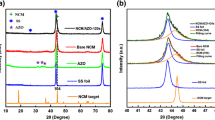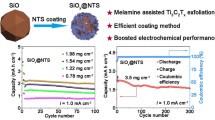Abstract
AlN/Co nanocomposite thin films were fabricated by pulsed laser deposition and investigated as new anode materials for lithium-ion batteries for the first time. The combination of electrochemically inactive AlN and Co in nanometer scale boosted the electrochemical performance of the thin films surprisingly. A high reversible capacity of 555 mAh·g−1 after 100 discharge–charge cycles at a current density of 500 mA·g−1 is obtained for the AlN/Co nanocomposite thin films, and 372 mAh·g−1 can be retained at a high rate up to 16C, exhibiting promising cycle stability and rate capability. The electrochemical reaction mechanism study reveals that Co nanoparticles could not only provide high electronic conductivity for the thin films, which facilitate the thorough decomposition of AlN in the initial discharge process, but also react with Li3N to form a new species Co2N during charge process, thus ensuring large capacity and high reversibility of AlN/Co nanocomposite thin films in subsequent cycles. This study provides a new perspective to design advanced electrode materials for lithium-ion batteries.







Similar content being viewed by others
References
Armand M, Tarascon JM. Building better batteries. Nature. 2008;451(7179):652.
Liu CF, Neale ZG, Cao GZ. Understanding electrochemical potentials of cathode materials in rechargeable batteries. Mater Today. 2016;19(2):109.
Murphy DW, Christian PA. Solid state electrodes for high energy batteries. Science. 1979;205(4407):651.
Hou YL, Wang RM, Zhang JT. Editorial for rare metals, special issue on nanomaterials and rechargeable battery applications. Rare Met. 2017;36(5):305.
Nitta N, Wu F, Lee JT, Yushin G. Li-ion battery materials: present and future. Mater Today. 2015;18(5):252.
Balaji S, Ananda Kumar M, Manichandran T, Mutharasu D. Electrodeposited three dimensional tin nano wire anode for thin film Li-ion micro batteries. Russ J Electrochem. 2016;52(3):226.
Wu J, Lau WM, Geng DS. Recent progress in cobalt-based compounds as high-performance anode materials for lithium ion batteries. Rare Met. 2017;36(5):307.
Salian GD, Lebouin C, Demoulin A, Lepihin MS, Maria S, Galeyeva AK, Kurbatov AP, Djenizian T. Electrodeposition of polymer electrolyte in nanostructured electrodes for enhanced electrochemical performance of thin-film Li-ion microbatteries. J Power Source. 2017;340:242.
Zargouni Y, Deheryan S, Radisic A, Alouani K, Vereecken MP. Electrolytic manganese dioxide coatings on high aspect ratio micro-pillar arrays for 3D thin film lithium ion batteries. Nanomaterials. 2017;7(6):126.
Quan Z, Hirayama M, Sato D, Zheng Y, Yano T, Hara K, Suzuki K, Hara M, Kanno R. Effect of excess Li2S on electrochemical properties of amorphous Li3PS4 films synthesized by pulsed laser deposition. J Am Ceram Soc. 2017;100(2):746.
Sun Q, Fu ZW. An anode material of CrN for lithium-ion batteries. Electrochem Solid State Lett. 2007;10(8):A189.
Zhou YN, Zhang H, Xue MZ, Wu CL, Wu XJ, Fu ZW. The electrochemistry of nanostructured In2O3 with lithium. J Power Source. 2006;162(2):1373.
Xie QS, Lin L, Ma YT, Yang JR, Huang J, Wang LS, Peng DL. Facile fabrication of ZnO–CuO porous hybrid microspheres as lithium ion battery anodes with enhanced cyclability. Rare Met. 2017;36(5):403.
Idota Y, Kubota T, Matsufuji A, Maekawa Y, Miyasaka T. Tin-based amorphous oxide: a high-capacity lithium-ion-storage material. Science. 1997;276(5317):1395.
Poizot P, Laruelle S, Grugeon S, Dupont L, Tarascon JM. Nano-sized transition-metal oxides as negative-electrode materials for lithium-ion batteries. Nature. 2000;407(6803):496.
Zhou YN, Xue MZ, Fu ZW. Nanostructured thin film electrodes for lithium storage and all-solid-state thin-film lithium batteries. J Power Source. 2013;234:310.
Lapp T, Skaarup S, Hooper A. Ionic conductivity of pure and doped Li3N. Solid State Ionics. 1983;11(2):97.
Huang H, Gao S, Wu AM, Cheng K, Li XN, Gao XX, Zhao JJ, Dong XL, Cao GZ. Fe3N constrained inside C nanocages as an anode for Li-ion batteries through post-synthesis nitridation. Nano Energy. 2017;31:74.
Balogun M, Zeng Y, Qiu W, Luo Y, Onasanya A, Olaniyi TK, Tong Y. Three-dimensional nickel nitride (Ni3N) nanosheets: free standing and flexible electrodes for lithium ion batteries and supercapacitors. J Mater Chem A. 2016;4(25):9844.
Caicedo JC, Zambrano G, Aperador W, Escobar-Alarcon L, Camps E. Mechanical and electrochemical characterization of vanadium nitride (VN) thin films. Appl Surf Sci. 2011;258(1):312.
Guzman RC, Yang J, Ming-Cheng Cheng M, Salley SO, Ng KYS. High capacity silicon nitride-based composite anodes for lithium ion batteries. J Mater Chem A. 2014;2(35):14577.
Dong S, Chen X, Gu L, Zhou XH, Xu HX, Wang HB, Liu ZH, Han PX, Yao JH, Wang L, Cui GL, Chen LQ. Facile preparation of mesoporous titanium nitride microspheres for electrochemical energy storage. ACS Appl Mater Inter. 2011;3(1):93.
Fu ZW, Wang Y, Yue XL, Zhao SL, Qin QZ. Electrochemical reactions of lithium with transition metal nitride electrodes. J Phys Chem B. 2004;108(7):2236.
Nandi DK, Sen UK, Sinha S, Dhara A, Mitra S, Sarkar SK. Atomic layer deposited tungsten nitride thin films as a new lithium-ion battery anode. Phys Chem Chem Phys. 2015;17(26):17445.
Pereira N, Dupont L, Tarascon JM, Klein LC, Amatucci GG. Electrochemistry of Cu3N with lithium: a complex system with parallel processes. J Electrochem Soc. 2003;150(9):A1273.
Pereira N, Klein LC, Amatucci GG. The electrochemistry of Zn3N2 and LiZnN: a lithium reaction mechanism for metal nitride electrodes. J Electrochem Soc. 2002;149(3):A262.
Zhou YN, Liu C, Chen HJ, Zhang L, Li WJ, Fu ZW. Electrochemistry of V2ON with lithium. Electrochim Acta. 2011;56(16):5532.
Anaraki-Ardakani H. A computational study on the application of AlN nanotubes in Li-ion batteries. Phys Lett A. 2017;381(11):1041.
Kusunose T, Sekino T. Improvement in fracture strength in electrically conductive AlN ceramics with high thermal conductivity. Ceram Int. 2016;42(11):13183.
Pan Y, Wu XJ, Zhang ZQ, Fu ZW, Zhou YN. Binder and carbon-free SbSn-P nanocomposite thin films as anode materials for sodium-ion batteries. J Alloys Compd. 2017;714(Supplement C):348.
Zhou YN, Zhang H, Wu XJ, Fu ZW. Li3N–Co nanocomposite: a new promising lithium-ion storage material. Electrochem Solid State Lett. 2008;11(4):A51.
Zhou YN, Wang XJ, Lee HS, Nam KW, Yang XQ, Haas O. Electrochemical investigation of Li–Al anodes in oligo(ethylene glycol) dimethyl ether/LiPF6. J Appl Electrochem. 2011;41(3):271.
Zhou YN, Liu WY, Xue MZ, Yu L, Wu CL, Wu XJ, Fu ZW. LiF/Co nanocomposite as a new Li storage material. Electrochem Solid State Lett. 2006;9(3):A147.
Zhou YN, Sina M, Pereira N, Yu X, Amatucci GG, Yang XQ, Cosandey F, Nam KW. FeO0.7F1.3/C nanocomposite as a high-capacity cathode material for sodium-ion batteries. Adv Funct Mater. 2015;25(5):696.
Acknowledgements
This study was financially supported by the National Natural Science Foundation of China (No. 51502039).
Author information
Authors and Affiliations
Corresponding author
Rights and permissions
About this article
Cite this article
Yan, Z., Niu, XY., Du, XQ. et al. Activating AlN thin film by introducing Co nanoparticles as a new anode material for thin-film lithium batteries. Rare Met. 37, 625–632 (2018). https://doi.org/10.1007/s12598-018-1013-2
Received:
Revised:
Accepted:
Published:
Issue Date:
DOI: https://doi.org/10.1007/s12598-018-1013-2




